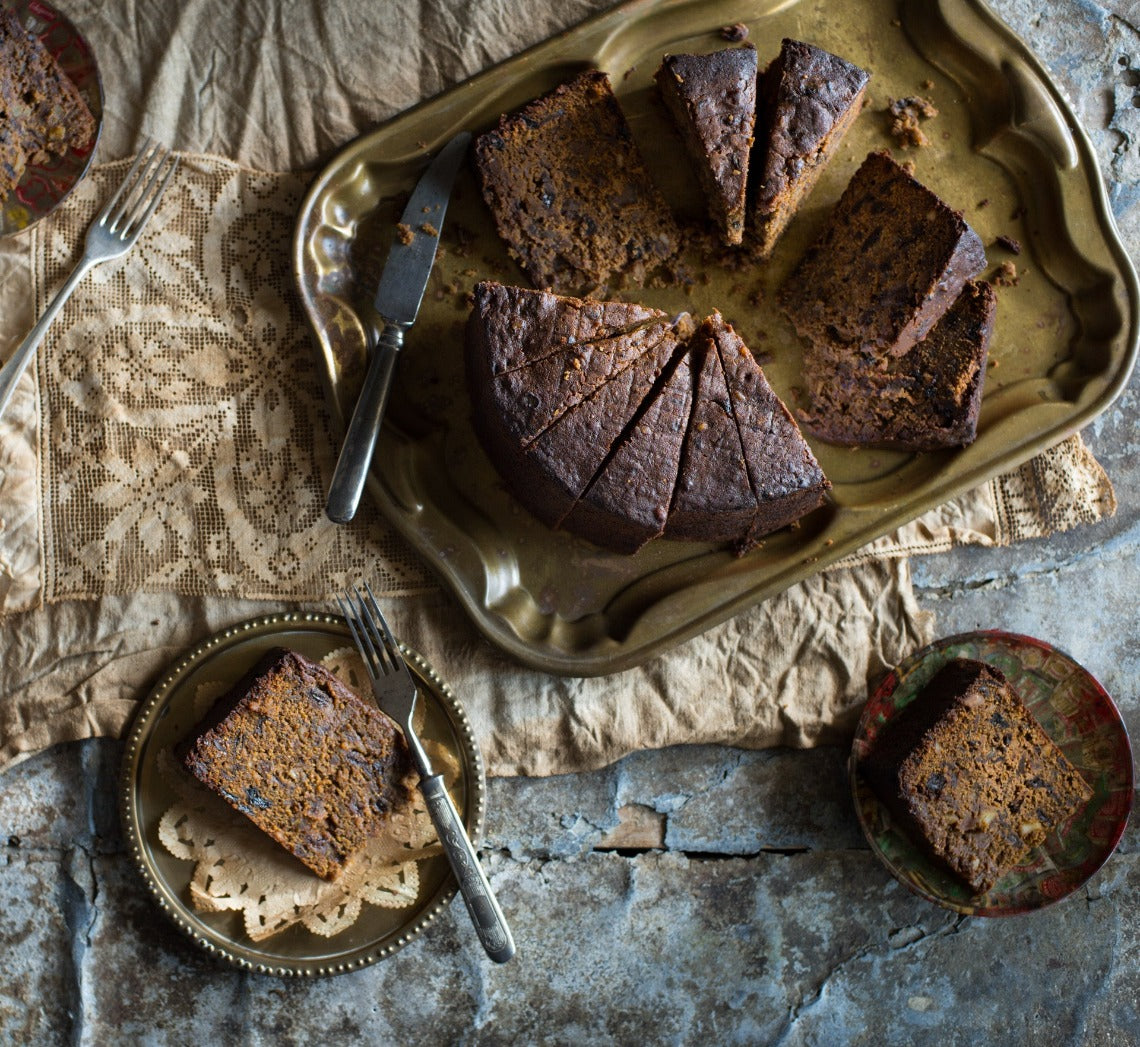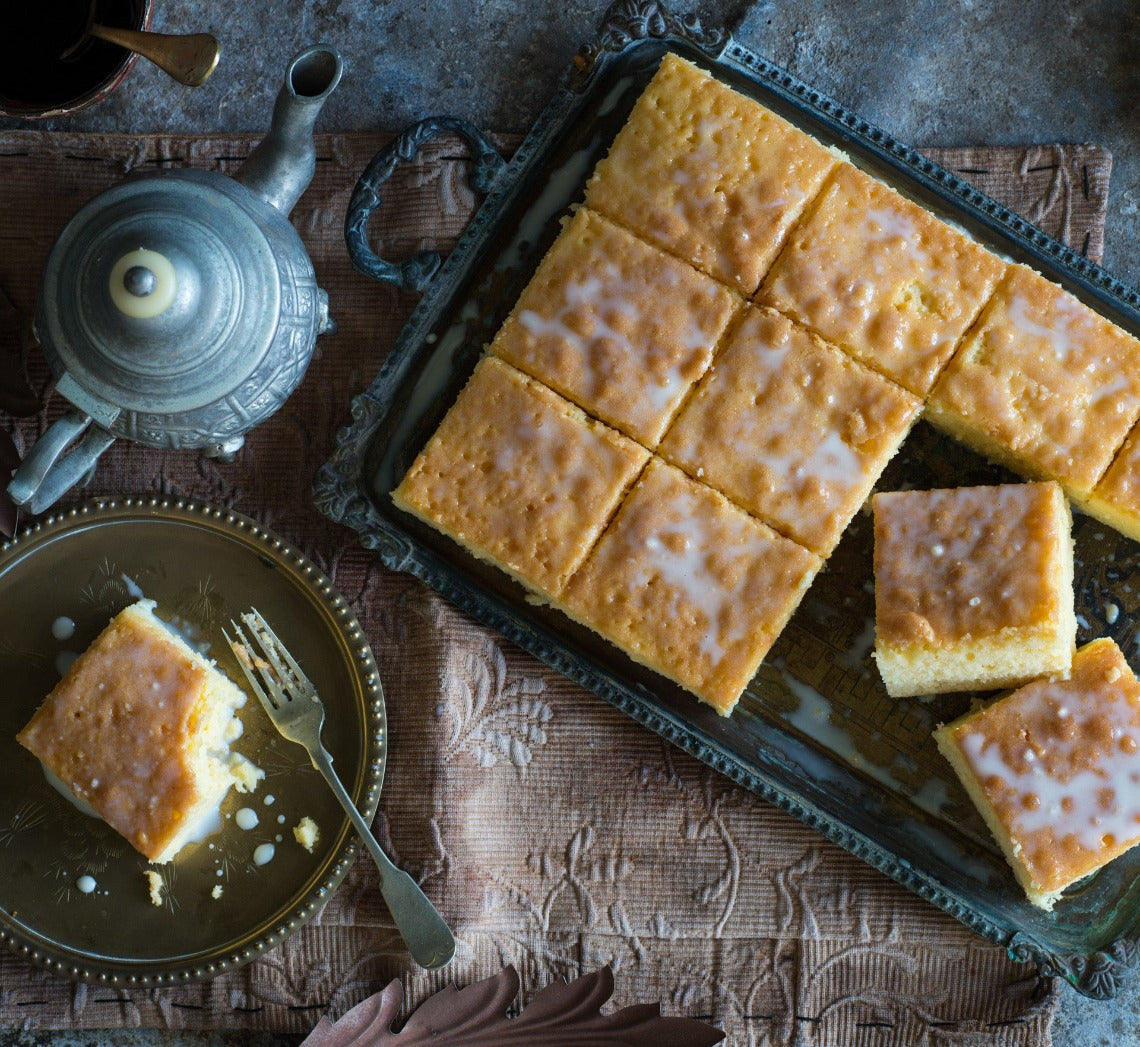- home
- BAKERECIPES
BakeRecipes
Bringing real baking into your home with deliciously simple recipes.

Prep 30min (+3days soaking and overnight cooling time)Bake 2hr 30minMakes 20 serves
This is Colombia’s version of a rich fruit cake. Dense with prunes, raisins and figs, generously spiked with both rum and port, and cleverly flavoured with aromatic spices, it is hard to stop at one piece. Traditionally dulce quemado (sweet burnt brown sugar), either homemade or bought, is used to sweeten this cake, but molasses makes a perfectly acceptable substitute as I've done in this recipe.
You will need to start this cake at least 6 days before baking.
Ingredients
200g (1 cup) pitted prunes
170g (1 cup) seedless raisins
80ml (⅓ cup) port, plus 80ml (⅓ cup) extra
60ml (¼ cup) dark rum, plus 60ml (¼ cup) extra
80g (½ cup) blanched almonds
50g (½ cup) pecans
melted butter, to grease
200g (1 cup) tenderised figs or drained figs in syrup (see Baker's Tips), finely chopped
250g butter, at room temperature
275g (1¼ cups) caster sugar
2 teaspoons vanilla essence
5 eggs, at room temperature
250g (1⅔ cups) plain flour
1 teaspoon baking powder
½ teaspoon ground cinnamon
¼ teaspoon ground nutmeg
¼ teaspoon ground cloves
¼ teaspoon salt
2 tablespoons molasses (see Baker's Tips)
Method
- Process the prunes and raisins in a food processor using the pulse button until chopped. Transfer to a bowl and stir in the port and rum. Cover and set aside for at least 3 days to soak (see Baker's Tips).
- Preheat oven to 170°C (150°C fan-forced). Grease a deep round 20 cm cake tin with melted butter and line the base and sides with non-stick baking paper.
- Process the almonds and pecans in a food processor until chopped. Add to the prune mixture with the figs and stir to combine evenly. Use an electric mixer to beat the butter, sugar and vanilla until pale and creamy, scraping down the sides of the bowl when necessary. Add the eggs one at a time, beating well after each addition.
- Sift together the flour, baking powder, spices and salt. Add to the butter mixture and beat on lowest possible speed until just combined. Add the molasses and beat on low until just combined. Use a wooden spoon to stir in the fruit and nut mixture until evenly combined.
- Spoon the mixture into the prepared tin, pressing well into the corners, and then smooth the surface with the back of a spoon. Cover the tin with a piece of foil and then bake in preheated oven for 2 hours and 25 minutes to 2 hours and 35 minutes or until cooked when tested with a skewer.
- Remove from the oven and stand in the tin for 10 minutes before turning onto a wire rack. Combine the extra port and rum and brush over the top of the cake. Wrap the warm cake in plastic wrap and then foil and set aside overnight to cool.
- Store for at least 3 days at room temperature before serving.
Baker's Tips
- The prunes and raisins require 3 days or more to soak, so you could start the soaking one weekend and cook the cake the next.
- Dulce quemado (sweet burnt brown sugar) is traditionally used in this cake and is considered more important than the alcohol or spices to add flavour. It not only adds a rich colour but also a sweet/bitter flavour to the cake. It can be home made or bought, although outside of Latin America it can be hard to track down. Molasses makes a good substitute.
- This cake will keep wrapped well in plastic wrap and sealed in an airtight container in a cool spot, but not in the fridge, for up to 3 months.
- To make the lattice pattern on the top of the cake as we have, turn the cake upside down on a cake rack after cooling and press down firmly. Turn the cake 90 degrees and press again.
This recipe is from Anneka's SBS Food online column, Bakeproof: Latin American Cakes.
CLICK HERE for more Bakeproof recipes.
Photography by Alan Benson.

Prep 30min (+3hr chilling and 2hr cooling time)Bake 35minMakes 12 serves
Immensely well-loved in Latin America, a recipe for this wonderfully milky cake appeared on the label of Nestle’s sweetened condensed milk cans in the 1940s, possible explaining why its popularity has spread so widely in this part of the world.
Ingredients
Sponge Cake
5 eggs, at room temperature
220g (1 cup/7¾oz) caster sugar
125g (4½oz) butter, melted
150g (1 cup/5¼oz) plain flour
75g (½ cup/2¾oz) self-raising flour
1 teaspoon natural vanilla essence or extract
Milk Syrup
395g tin sweetened condensed milk
150ml evaporated milk
250ml (1 cup) full-cream milk
Method
- Preheat the oven to 180°C/350°F (160°C/315°F fan-forced). Grease a 20cm x 30cm (8in x 12in), base measurement, shallow cake tin or lamington pan and line the base and two longs sides with one piece of non-stick baking paper.
- Use an electric mixer with a whisk attachment to whisk the eggs on high speed until combined. Gradually add the sugar, about 55g (¼ cup/2oz) at a time, whisking well after each addition. Once all the sugar has been added, whisk on high for a further 4 minutes or until the mixture is very thick and a ribbon trail forms when the whisk is lifted. Reduce the mixer speed to low and gradually add the melted butter, whisking until just incorporated. Sift together the plain and self-raising flours. Add to the egg mixture in three separate batches, whisking on low speed between each addition until just combined and scraping the bottom of the bowl when necessary to make sure all the flour is incorporated.
- Pour batter into the prepared tin and gently tap it on the bench three times to remove any excess air bubbles. Bake in preheated oven for 30-35 minutes or until the cake is firm when touched in the centre and a skewer inserted in the centre comes out clean.
- Just before the sponge is ready, make the Milk Syrup by combining the sweetened condensed milk, evaporated milk and milk in and bowl and stirring with a balloon whisk until well combined. Transfer to a jug.
- Remove the sponge from the oven and stand in the tin for 3 minutes before inverting onto a tray with a lip. Use a skewer to prick holes all over the surface of the cake and all the way through. Pour the milk mixture evenly and slowly over the warm cake, allowing it to soak it up. Stand at room temperature until cool (this will take about 2 hours) and then refrigerate, uncovered, for 3 hours or overnight. Cut into pieces to serve (see Baker's Tips).
Baker's Tips
- For an extra rich cake you can top it with 375 ml (1½ cups) thickened cream that has been whisked to soft peaks with 2 tablespoons of sifted icing sugar and 1 teaspoon of natural vanilla essence or extract before serving.
- This cake will keep covered in the fridge for up to 3 days. Serve at room temperature.
This recipe is from Anneka's SBS Food online column, Bakeproof: Latin American Cakes.
CLICK HERE for more Bakeproof recipes.
Photography by Alan Benson.

Prep 1hr15min (+2hr chilling and 1hr cooling time)Bake 1hr20minMakes 10 serves
This blissful combination of sponge cake, cream, meringue, dulce de leche and peaches takes its name from a native Uruguayan bird – apparently the meringues resemble the features of a chaja bird. I must admit I find it hard to see the resemblance and feel this wonderful cake has been dealt a slight disservice in its naming!
Ingredients
400g (14oz) tin sliced peaches in juice
55g (¼ cup/2oz) caster sugar
2 tablespoons peach-flavoured liqueur or schnapps
300ml (10¼fl oz) thickened cream
1 teaspoon natural vanilla essence or extract
2 x 20cm/8in sponge cakes
225g (¾ cup/8oz) dulce de leche, warmed gently to a spreadable consistency
Meringues
2 egg whites (from 60g/2oz eggs)
110g (½ cup/4oz) caster sugar
1 teaspoon vanilla essence
Method
- To make the Meringues, combine the egg whites and sugar in a medium heatproof bowl (preferably metal) and place over a saucepan of simmering water, ensuring the bowl doesn’t touch the water. Stir with a spatula or small whisk until the sugar dissolves and the mixture is hot to touch (about 55-60°C on a sugar thermometer). Be careful not to allow the egg whites to cook.
- Transfer the egg white mixture to the bowl of an electric mixer (see Baker’s Tips). Whisk the egg white mixture with a whisk attachment on medium-high speed until very thick and glossy and the mixture has cooled to room temperature. Whisk in the vanilla and cornflour.
- Fill a large piping bag fitted with a 4B star (or #11/11mm/½in round) piping nozzle with the meringue mixture. Holding the piping nozzle about 1cm/½in above the tray, pipe small rosettes (or 'kisses') about 2.5cm/1in in diameter and 2cm apart on the lined tray.
- Bake in a preheated oven for 60-70 minutes or until the meringues are crisp, hard to touch and peel away from the tray easily, but are not coloured. Remove the meringues from the oven and place immediately in an airtight container lined with absorbent paper.
- Drain the peach slices, reserving 100ml (3½fl oz) of the juice. Set the peach slices aside. Combine the reserved juice in a small saucepan with the sugar and stir over low heat until the sugar dissolves. Bring to a simmer and simmer gently for 2 minutes to reduce slightly. Remove from the heat and stir in the peach-flavoured liqueur or schnapps.
- Use an electric mixer with a whisk attachment on medium-low speed or a balloon whisk to whisk the cream and vanilla until soft peaks form.
- To assemble the cake, turn the sponge layers upside down and brush with half the peach syrup. Turn the sponges right side up and brush with the remaining syrup. Place one layer on a serving plate and spread with half the dulce de leche. Spread with half of the whipped cream. Crumble over about 12 of the meringues and then top with the reserved peach slices. Cover with the remaining sponge layer. Spread the top with the remaining dulce de leche and then the remaining cream. Decorate the top with the remaining meringues. Serve immediately.
Baker's Tips
- The assembled cake, without the meringues on top, will keep in the fridge for up to 3 hours before serving. Stand at room temperature for 30 minutes before serving.
- The fan-forced setting is often too intense for baking meringues and will cause them to crack. If this is the case with your oven, opt for the conventional setting. However, if the meringues do crack when using the convention setting, your oven may be running a little hot and next time reduce the temperature by 5-10°C (41-50°F) as this will often help prevent them from cracking.
- If you don't have a small bowl for your mixer, first whisk the egg white mixture with a balloon whisk until it is foamy and doubled in volume before whisking with the stand mixer. This will make the whisking of the egg white mixture more efficient in a standard size bowl.
- Allowing the egg white mixture to come to room temperature before whisking will reduce the time it will take to whisk it to a meringue.
- The meringues will keep in an airtight container at room temperature for up to 1 week.
This recipe is from Anneka's SBS Food online column, Bakeproof: Latin American Cakes.
CLICK HERE for more Bakeproof recipes.
Photography by Alan Benson.






